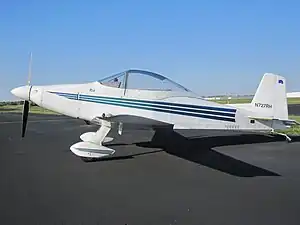Mustang Aeronautics Mustang II
The Mustang Aeronautics Mustang II is a two-seat aerobatic sports airplane developed and marketed in the United States for homebuilding.[1][2][3]
| Bushby Mustang II | |
|---|---|
 | |
| Mustang II | |
| Role | Aerobatic sports plane |
| Manufacturer | Mustang Aeronautics for Homebuilding |
| Designer | Robert Bushby |
| First flight | 9 July 1966 |
| Status | In production (2015) |
| Produced | 480 (2011)[1] |



Design and development
Robert Bushby acquired the rights to the Long Midget Mustang in 1959 and four years later began development of a two-seat, side-by-side version. This eventually flew in 1966 and plans were made available soon thereafter.[4] Rights to both the Midget Mustang and the Mustang II were sold to Mustang Aeronautics in 1992. [5] A single engine in tractor configuration airplane, the Mustang II features cantilever low-wing, two-seats-in-side-by-side configuration enclosed cockpit under a bubble canopy, fixed conventional landing gear, or, optionally, tricycle landing gear.[2][3]
The aircraft is made from riveted sheet aluminum with a rounded turtle deck and flat sides and bottom skins.[6] Its 24.2 ft (7.4 m) span wing employs a NACA 64A212 airfoil at the wing root, transitioning to a NACA 64A210 at the wingtip. Standard engines used include the 150 to 160 hp (112 to 119 kW) Lycoming O-320, the 180 hp (134 kW) Lycoming O-360 and the fuel-injected 200 hp (149 kW) Lycoming IO-360 four-stroke powerplants.[2][7] Standard fuel capacity is 25 US gallons, but optional wet wings increase the fuel capacity to 61 US gallons.[8] Several other fuel tank options are available.[9] A folding wing option may be installed.[10]
Specifications
General characteristics
- Crew: One pilot
- Capacity: 1 passenger (2 total)
- Length: 19 ft 6 in (5.94 m)
- Wingspan: 24 ft 2 in (7.37 m)
- Height: 5 ft 3 in (1.60 m)
- Wing area: 97 sq ft (9.0 m2)
- Empty weight: 927 lb (420 kg)
- Gross weight: 1,500 lb (680 kg)
- Powerplant: 1 × Lycoming O-320 air-cooled horizontally-opposed four-cylinder engine , 160 hp (120 kW)
Performance
- Maximum speed: 230 mph (370 km/h, 200 kn)
- Range: 430 mi (692 km, 370 nmi)
- Service ceiling: 21,000 ft (6,400 m)
References
- Vandermeullen, Richard: 2012 Kit Aircraft Buyer's Guide, Kitplanes, Volume 28, Number 12, December 2011, page 62. Belvoir Publications. ISSN 0891-1851
- Bayerl, Robby; Martin Berkemeier; et al: World Directory of Leisure Aviation 2011-12, page 113. WDLA UK, Lancaster UK, 2011. ISSN 1368-485X
- Tacke, Willi; Marino Boric; et al: World Directory of Light Aviation 2015-16, page 119. Flying Pages Europe SARL, 2015. ISSN 1368-485X
- Flying Magazine: 53. October 1966.
{{cite journal}}: Missing or empty|title=(help) - "Mustang Aeronautics - About". Manufacturer's web site. Retrieved 2015-08-22.
- "What kind of airplane should you build". Air Progress Sport Aircraft: 41. Winter 1969.
- Lednicer, David (2010). "The Incomplete Guide to Airfoil Usage". Archived from the original on 20 April 2010. Retrieved 3 January 2012.
- "Mustang II Specifications". Manufacturer's web site. Retrieved 2015-06-23.
- "M-II FAQs Fuel Options". Manufacturer's web site. Retrieved 2015-06-23.
- "Mustang II Folding Wing". Manufacturer's web site. Retrieved 2015-06-23.
- Taylor, Michael J. H. (1989). Jane's Encyclopedia of Aviation. London: Studio Editions. p. 225.
- Jane's All the World's Aircraft 1987-88. London: Jane's Publishing Company. pp. 646–47.
- Manufacturer's website - Mustang II History